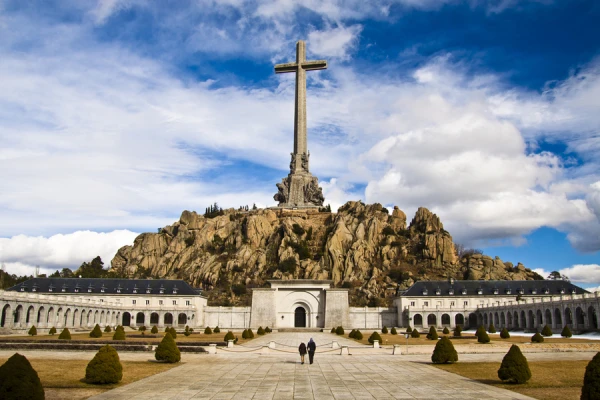
CNA Staff, Oct 28, 2020 / 03:01 am (CNA).- The Valley of the Fallen is a monumental complex near Madrid which includes an abbey and basilica, and which honors the fallen of both sides during the Spanish civil war. The bodies of more than 30,000 victims of the war are buried in the complex.
Among them lie 57 Blesseds and 15 Servants of God.
The Spanish Civil War of 1936-39 was fought between the Nationalist forces, led by Francisco Franco, and the Republican faction. During the war, Republicans martyred thousands of clerics, religious, and laity; of these, 11 have been canonized, and 1,915 beatified.
Fr. Santiago Cantera, prior of the Abbey of the Holy Cross, recently spoke at an event organized by the Diocese of Barbastro-Monzón to commemorate the martyrs who died during the religious persecution of the Civil War. The prior highlighted some of the common characteristics of the martyrs, who came from diverse backgrounds.
The martyrs who are buried in the Basilica of the Holy Cross “are the finest testimony of forgiveness and reconciliation” and belong to all states in life: “laity, diocesan and religious priests, consecrated men and women religious, people of all ages, but also a large group of young people, such as Rafael Lluch, a 19-year-old member of Vincentian Youth and Catholic Action,” Cantera explained.
Acceptance of martyrdom
One aspect the martyrs all share in common, Cantera highlighted, was their "acceptance of martyrdom," giving "the finest testimony for peace, forgiveness and the reconciliation of the Spanish people, because they died forgiving their executioners without any hatred.”
Blessed Juan Pedro de San Antonio, a 46 year-old Passionist priest, was hiding in a boarding house along with four other brothers from the congregation. He told the owner of the boarding house that “if anyone takes us out to shoot us, I ask that no one bear hatred or resentment for the evil they are thinking of doing to us. The Lord allows it for our sanctification.”
Before dying, Fr. Antonio Martínez Lópe said he wanted to bless his executioners, but they struck his arm and broke it before killing him. "These are examples of the peace with which they died, in the absence of hatred, with the will to forgive and to reconcile," the prior noted.
A supernatural outlook
Another common element is "the supernatural outlook they had at the time of martyrdom,” Fr. Cantera said. These martyrs "looked to eternity, they lived out the love of God and this led them to imitate Christ even to the ultimate consequence, accepting death as having a redemptive meaning for all men.”
During the years of religious persecution in Spain it was common for the martyrs to say goodbye with the words "Until (we meet again in) Heaven.”
Rafael Lluch, the youngest of the martyrs buried in the Basilica of the Holy Cross, was arrested for carrying a holy card of the Virgin of the Forsaken in his pocket and belonging to the association of the Miraculous Medal. The young man said goodbye to his mother saying: "Don't cry, I'm going to give my life for our God, I'll wait for you in Heaven."
"Long live Christ the King” were also the last words of many of the martyrs, such as Blessed Florencio López Egea, whose executioners stuck thorns in his eyes demanding he blaspheme, but he always replied "Long live Christ the King."
Also sharing this supernatural outlook are the 23 sisters belonging to the Adorers of the Blessed Sacrament. Seven of them are buried in the Basilica of the Holy Cross.
When they were riding in a truck on the way to being shot, “they all knelt down to receive the Sacred Hosts that they had kept in a watch case,” Fr. Cantera related. “The driver of the truck carrying them after they had been arrested told his wife how much he admired them: ‘I saw them all die, most of them young, with smiles on their faces and blessing God. What women. They were Adorers.'”
Love for the priesthood
Another common aspect of the martyrs is "their love for the priesthood and the priestly ministry," the prior said, citing Blessed Enrique López Ruiz. An altar boy described him as "a true apostle of Jesus Christ." The militiamen wanted to stop him from offering Mass, but he refused to leave his parish and the faithful.
The "willingness to die and be martyred, offered in immolation for the salvation of Spain" is also a hallmark of the martyrs.
Blessed Josefa María, a Salesian sister, refused the offer to hide in the house of a relative whom she told: "If Spain has to be saved by the shedding of our blood, we ask God for it to be as soon as possible." Or Blessed Florencio López, who on his way to be shot was singing a song he had composed himself asking the Virgin "to save quickly the Spanish people.”
Enduring torture and cruelty
Cantera also pointed to the cruelty suffered by the martyrs, to which they responded with their love for God and by offering their lives for Spain, as did Fr. Domingo Campoy, a curate of a parish in Almería who was tortured on one of the prison ships.
This priest served in the military as a chaplain and interceded for the release of a soldier who had been arrested who later became one of his executioners.
Serving the needy
The prior noted that almost all of them dedicated a large part of their lives to performing works of charity, such as the Adorers of the Blessed Sacrament, whose charism is helping young women at risk of falling into prostitution.
Fr. Cantera also wanted people “to know the great spiritual wealth and theological mark sealed upon his soul by the Valley of the Fallen as an authentic place of peace and reconciliation in the shadow of the redemptive Cross, a symbol that reminds us of the redemption of Christ, the reconciliation that God has accomplished to which he invites all men."
The Valley of the Fallen
The complex was inaugurated in 1959 under Franco, who was Spain's head of state from the end of the Spanish Civil War, when the Nationalist forces he led defeated the Republican faction, until his death in 1975.
The government of Pedro Sanchez, secretary-general of the Spanish Socialist Worker's Party, in September introduced the Law on Democratic Memory.
The bill seeks to transform the Valley of the Fallen into a civil cemetery, and would expel the Benedictine community. It would also bar publicly funded groups from glorifying Franco, the BBC reported.
While removing the 150 meter cross that presides over the valley is not explicitly mentioned in the bill, it has been considered on other occasions.
Franco's body was exhumed from the Basilica of the Holy Cross in October 2019 by the Sanchez government. Fr. Cantera said the exhumation failed to respect the inviolability of the abbey as a sacred place.
If you value the news and views Catholic World Report provides, please consider donating to support our efforts. Your contribution will help us continue to make CWR available to all readers worldwide for free, without a subscription. Thank you for your generosity!
Click here for more information on donating to CWR. Click here to sign up for our newsletter.





Spain’s civil war parallel’s our World crisis. From savior of Spain and moral sanity Catholic Generalissimo Franco to secular socialist morally bankrupt Presidente del Gobierno de España Pedro Sánchez, a battle won and battle on the verge of total loss, destruction of all that is good, all that is holy. Dread has factored into my life not after reading Kierkegaard on Angst rather after reading Catherine of Siena, The Dialogue of the Seraphic Virgin Catherine of Siena [best ed Algar Thorold London 1907]. What became clear is how easy it is to fall into the flaming pit of eternal damnation and the great difficulty in saving ourselves. Saint Catherine as great a saint as she is feared terribly when death approached, repeating that the Precious Blood is the key to salvation. Alluding to a must life of heroic virtue and reparation for our sins. I waver between conviction we’re at the threshold of the Final Battle and there’s ample time, or rather that we’re at this moment in the Final Battle. That the kathèkon as Archbishop Viganò believes is about to be removed and Antichrist revealed. There are just too many credentialed prelates from Cardinals Caffarra to Burke, Eijk, and now the usually reserved Cardinal Gerhard Müller. Consider the entire American media in absolute [except for lonely Fox] collusion to omit facts propogate lies and propaganda, that so many Americans hate not simply Trump but what he stands for, his opposition to abortion, Marxist socialism, that the Pontiff sides with the Dem Party, and by clear implication its agenda of abortion, Marxist socialism, secularist global brotherhood. The Mystery of Iniquity is precisely what the Catechism describes as a religious deception that assures the fallen that their worries are relieved, that as the Sandals commercial says they can do what they want when they want. And it is Pope Francis who has provided that deception in his subversive doctrine of mercy absent of repentance.
Sanchez and his satanic followers have rejected forgiveness and reconciliation. Scripture is quite clear the ultimate destiny of those who do so. The Spanish civil war was a preview of a long struggle between good and evil in the world and, contrary to common belief at the time, was not over with the apparent fall of communism in 1989-91. Like a serpent’s head, it still kills even with the head cut off.